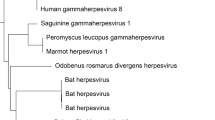Summary
The oncogenicity of the human polyomavirus BK (BKV) was tested in newborn inbred rats.
It was found that the tumor rate was negatively correlated with the levels of T antibody 3 months after inoculation and the frequency of animals with detectable T antibodies 1.5 months after inoculation.
By contrast, no influence of viral HI titers on the tumor rates was found. Thymectomy of animals resulted in most experiments in increased tumor rates. Inoculation with BKV of animals later than 24 hours after birth yielded a decrease of tumor rates.
The results obtained suggest that T antibody titers present at a critical time after inoculation are associated with low oncogenicity of BKV.
The oncogenicity of BKV was comparatively tested in rat strains possessing the allele “l” or the allele “a”, respectively. The oncogenicity was significantly higher in rats with the allele “l” than in rats with the allele “a”. Rats with the allele “l” showed lower T antibody response than rats with the allele “a”.
These differences could be explained by the finding that cells of “a” origin showedin vitro a higher percentage of T antigen bearing cells than did cells of a strain possessing the allele “l”. In comparison to previous results obtained with BKV inoculated outbred WISTAR rats, the oncogenicity of comparable BKV doses in inbred rats was generally higher and the latency period of tumor manifestation shortened.
Similar content being viewed by others
References
Brown, P., Tsai, Th., Gajdusek, D. C.: Seroepidemiology of human papovaviruses. Amer. J. Epidemiol.102, 331–340 (1975).
Chesters, P. M., Heritage, J., McCance, D. J.: Persistence of DNA sequences of BK virus and JC virus in normal human tissues and in diseased tissues. J. Infect. Dis.147, 676–684 (1983).
Corallini, A., Barbanti-Brodano, G., Bortoloni, W., Nenci, I., Cassai, E., Tampieri, M., Portolani, M., Borgatti, M.: High incidence of ependymomas induced by BK virus, a human papovavirus: Brief communication. J. Natl. Cancer Inst.59, 1561–1563 (1977).
Corallini, A., Altavilla, G., Carra, L., Grossi, M. P., Federspil, G., Caputo, A., Negrini, M., Barbanti-Brodano, G.: Oncogenicity of BK virus for immunosuppressed hamsters. Arch. Virol.73, 243–253 (1982).
Debré, P., Boyer, B., Gisselbrecht, S., Bismuth, A., Lévy, J.-P.: Genetic control of sensitivity to moloney leukemia virus in mice. III. The three H-2 linked Rmv genes are immune response genes controlling the antiviral antibody response. Eur. J. Immunol.10, 914–918 (1980).
Diamandopoulos, G., McLane, M.: Development of antibodies to viral and tumor antigens before tumor induction in syrian golden hamsters inoculated intravenously at 3 weeks of age with SV 40. J. Immunol.113, 1450–1456 (1974).
Gardner, S. D.: Prevalence in England of antibody to human papovavirus (B.K.). Brit. Med. J.1, 77–78 (1973).
Godding, L. R., Geib, R. W., O'Connor, K. A., Harlow, E.: Antibody and cellular detection of SV 40 T-antigenic determinants on the surface of transformed cells. In: Cold spring harbor conference on cell proliferation and cancer 11. New York: Cold Spring Harbor Laboratory (in press, 1984).
Goudsmit, J., Wertheim-van Dillen, P., van Strien, A., van der Noordaa, J.: The role of BK virus in acute respiratory tract disease and the presence of BKV DNA in tonsils. J. Med. Virol.10, 91–99 (1982).
Günther, E., Rüde, E., Stark, O.: Antibody response in rats to the synthetic polypeptide (T, G)-A-L genetically linked to the major histocompatibility system. Eur. J. Immunol.2, 151–155 (1972).
Miller, J. F. A. P.: Immunological function of the thymus. Lancet2, 748–749 (1961).
Noss, G., Stauch, G., Mehraein, P., Georgii, A.: Oncogenic activity of the BK type of human papovavirus in newborn wistar rats. Arch. Virol.69, 239–251 (1981).
Shah, K. V., Daniel, R. W., Strandberg, J. D.: Sarcoma in a hamster inoculated with BK virus, a human papovavirus. J. Natl. Cancer Inst.54, 945–951 (1975).
Stauch, G., Schmidt, G., Georgii, A.: Differences in morphology of polyoma H-SE induced tumors in fetal and newborn rats. Verh. Dtsch. Ges. Path.65, 321–324 (1981).
Weber, E.: Grundriss der Biologischen Statistik, 4th ed. Jena: VEB Gustav Fischer 1961.
Wonigeit, K.: Medizinische Hochschule Hannover (W.-Germany), personal Communication.
Würzburg, U., Schütt-Gerowitt, H., Rajewsky, K.: Characterisation of an immune response gene in rats. Eur. J. Immunol.3, 762–766 (1973).
Author information
Authors and Affiliations
Rights and permissions
About this article
Cite this article
Noss, G., Stauch, G. & Drescher, J. Oncogenic activity of the BK type of human papova virus in inbred rat strains. Archives of Virology 81, 41–51 (1984). https://doi.org/10.1007/BF01309295
Received:
Accepted:
Issue Date:
DOI: https://doi.org/10.1007/BF01309295




